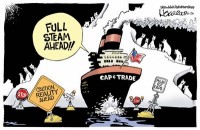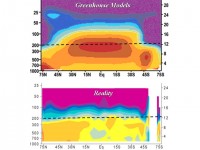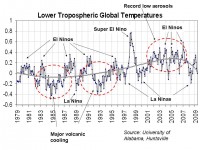By Mackubin Thomas Owens, Boston Herald
While the attention of the American public was focused on the circus surrounding the death of Michael Jackson, the House of Representatives was laying the groundwork for picking that same publicís pockets. The Waxman-Markey energy bill, set for debate later this year in the Senate, would hamstring the U.S.
economy, raise unemployment and burden taxpayers. The centerpiece of the legislation is a “cap and trade” provision designed to reduce carbon dioxide (CO2) emissions by raising the price of CO2-intensive goods and services such as gasoline, electricity and many industrial products. Legislation should be subjected to some basic cost-benefit analysis. This bill provides little in the way of benefits to Americans but imposes very high costs.
The goal of the bill is to reduce greenhouse gas emissions that allegedly cause “global warming,” or as it is now known, “climate change.” But global temperatures have been decreasing since 1998. On the benefits side, there is another problem. Even if the United States were to significantly reduce CO2
emissions, it would have little global effect, given that the biggest producers of greenhouse gas emissions are rapidly developing countries such as China and India. And U.S. businesses have reduced such emissions in response to market forces.
On the other hand, the costs of something along the lines of Waxman-Markey are staggering. Carbon-based fuels (oil, coal, natural gas) provide about 85 percent of U.S. energy needs and generate most greenhouse gases. Companies would need annual allowances issued by the government in order to emit greenhouse gases.
Under the “cap” part of the bill, these allowances would gradually decline. Indeed, Waxman-Markey requires the CO2 level in 2050 to be 83 percent less than it was in 2005. The “trade” permits utilities and refineries that need extra allowances to buy them from other companies. As the annual allowances allowed by Washington are reduced, their price would rise. The EPA estimates that the price of a permit would rise from $20 a ton in 2020 to $75 a ton by 2050. Companies would pass the extra cost to customers.
The Congressional Budget Office estimates that reducing the level of CO2 to 15 percent less than the total level of emissions in 2005 would increase a householdís annual cost of living by $1,600. Meanwhile, American companies would suffer in export markets as American prices rose. Domestic
producers would suffer because of competition from imports from countries that do not impose the CO2 tax. The idea that we can shift effortlessly from carbon-based fuels to alternative “clean” forms of energy and conservation is a pipedream. Population increases in the United States alone will raise energy demand. If the supply of electricity doesn’t keep pace with demand, brownouts, blackouts or other disruptions would mount.
Western European countries have found that it is very difficult and expensive to reduce carbon emissions. Nearly every western European state has had higher unemployment and energy costs than America, and a weaker overall economy. And the promise of the new “green” economy is proving elusive as well. Let’s hope the Senate does a better job of cost-benefit analysis than the House. It should not be Washington’s job to wreck the economy.
By Alan Caruba
If there is one thing Americans began to rapidly conclude following his inauguration in January, it is that President Barack Obama lies all the time and that those lies are often blatant. In pursuit of the “Cap-and-Trade” act that is a huge tax on all energy use in America, Obama’s favorite mantra is that massive subsidies to wind and solar energy producers, as well as biofuel producers, will generate millions of new “green” jobs. Perhaps the worst part of this lie is that they will actually destroy jobs.
In the July edition of Energy Tribune, Michael Economides and Peter Glover co-authored “Green Jobs: Fast-Tracking Economic Suicide.” I know Economides and he is internationally recognized as one of the world’s authorities on energy issues. “Creating ex nihilo - literally, out of nothing - used to be a theological concept, God’s prerogative. Today, it seems, President Obama and certain Western politicians claim to possess the ability to do it,” write the article’s authors. “Against all the laws of economics and the marketplace, President Obama and others believe they can create millions of ‘green’ jobs ex nihilo, literally out of thin air, via cap and trade.”

There are two driving forces behind Cap-and-Trade. One is the claim that “green” energy producers will generate new jobs if the government just provides a combination of legislative mandates for its use (wind and solar) and, two, that a massive new trading apparatus in “carbon credits” for the generation of “greenhouse gas emissions” will protect the Earth against “global warming.”
It is increasingly obvious to everyone that the Earth is cooling, breaking thousands of previous records for cool weather in cities around America and similar conditions worldwide. The tide, too, is turning against the “global warming” hoax that is failing in the face of the obvious cooling weather and climate. Using “global warming” to justify any government mandates or to empower the Environmental Protection Agency to regulate carbon dioxide as a “pollutant” is a lie. It is a very big lie. Carbon dioxide is vital to all life on Earth.
As the Energy Tribune authors point out, “To generate real industrial jobs, however, you need a basic commodity to trade, such as oil, gas or coal.” This is in marked contrast to wind and solar energy. “The trouble is that alternative energy technologies currently don’t work. That is to say, they remain inefficient, offering a very poor energy return on investment.” “Cut off the flow of public subsidies and the alternative energy industrial revolution would grind to a halt tomorrow.”
In the real world, in 2008 the Marcellus gas industry in Pennsylvania generated $2.3 billion in total value added, more than 29,000 jobs, and $240 million in state and local taxes. If you extrapolate that to other sectors of the energy industry, you would be looking at thousands of real jobs, not lost jobs, but President Obama and his sycophants would rather you not know about that.
If you had a choice, would you prefer to see wind, solar and biofuel energy producers receive billions in taxpayer subsidies or would you prefer to see independent energy producers permitted to extract oil and natural gas or the coal industry have access to the U.S. reserves that would provide electricity for centuries to come? This is not mere conjecture. The experience of European Union nations demonstrates that “for every green job created, a real job is destroyed elsewhere in the economy.” Carbon regimes drive manufacturing to nations that do not impose limits on coal, oil and natural gas.
For example, “Germany’s Angela Merkel is insisting on major exemptions for German heavy industry come December’s global climate summit in Copenhagen. Merkel’s government is also supporting the building of 26 new coal-fired power plants across Germany.” Compare that with one hundred such plants whose construction was thwarted in the United States by environmental groups such as the Sierra Club and Friends of the Earth.
‘In June, deputy head of Poland’s Solidarity trade union, Jaroslaw Gresik, estimated that the EU’s climate policy would cost 800,000 European jobs.” Widely circulated data from a study of the heavily subsidized wind and solar energy industry in Spain revealed that its alternative energy program destroyed nearly 110,500 jobs elsewhere in its economy or 2.2 jobs destroyed for every ‘green job’ created. Consumers there have seen their electricity rate increase by 31 percent.
Other independent studies reveal that Obama’s claim of five million new “green” jobs would cost an estimated $500 billion to create. Wake up, America! The Big Lie about “Green jobs” is going to cost jobs. The Cap-and-Trade bill is a massive tax increase.
The summer recess is the time to contact your Senator and Representative and tell them you oppose Cap-and-Trade. If it is passed, it will undermine the economy, cost jobs, and leave the nation increasingly dependent on the import of energy resources while our own lay underground, unexplored, untapped, unused. Read post here.
By Myron Ebell
I was interested to read an item in today’s Climate Wire about a new report by “a prominent Australian scientist.” Andrew Macintosh of the Australian National University has “spent months modeling 45 different climate change scenarios” and concluded that the target recently agreed by leaders of G-8 nations to limit the global mean temperature increase to two degrees Centigrade could not be met with policies currently in place or being considered.
What caught my attention in this story was the description of Macintosh as a prominent climate scientist. That’s how computer modelers are routinely described by the global warming alarmists, and the mainstream communications media routinely accept this description. Climate modelers may have all sorts of qualifications and be absolutely brilliant at using computer models, but those qualifications do not necessarily include knowing much about climatology or meteorology or related fields, such as physics, oceanography, geology, chemistry, biology, etc.
Since I’d never heard of the prominent Professor Macintosh, I decided to look him up on the internet. I was surprised to find that he’s not a computer modeler at all! He’s a lawyer! And his position at ANU is Associate Director of the Centre for Climate Law and Policy. He does have a diploma in environmental studies on top of his 1998 bachelor of commerce and law degree, but he won a prize for environmental law, so that’s probably what he concentrated on while earning his diploma in 2001.
That’s what it takes to be described as a prominent climate scientist if you’re on the alarmist side. While rummaging around on the internet, I also found the transcript of an April 15 story broadcast by the Australian Broadcasting Corporation. The story starts by interviewing two climate skeptics, Professor Bob Carter, a geologist, and Professor Stewart Franks, an environmental engineer. They told a parliamentary commission that the scientific evidence doesn’t support alarmism. But then the reporter, Sabra Lane, was quick to point out that Carter and Franks aren’t climate scientists or even reputable scientists at all.
Sabra Lane: “Climate scientist Professor David Karoly says neither Professor Carter nor Franks is recognised as a reputable climate scientist.” David Karoly: “Bob Carter and Stewart Franks are in fact in a minority of both scientists and climate scientists in Australia. In fact neither of them is a climate scientist who publishes actively in the climate science literature.” But here is the very next sentence of ABC’s news story. Sabra Lane: “And Professor Andrew Macintosh from the ANU’s Centre for Climate Law and Policy says the Governmentís planned cuts to emissions of 5 to 15 per cent by 2020 aren’t enough.” Having elevated Mr. Macintosh to the ranks of the professoriate, Correspondent Lane does not go on to question his qualifications
I don’t mean to question Mr. Macintosh’s report. I haven’t read it. It may be first rate, although I hope that he is more cautious about the forecasting abilities of computer climate models (which are nil) than his newspaper quotes suggest. My point is that prominent scientists with long publications records, such as Bob Carter, are routinely described by the media as not being climate scientists and really not reputable scientists at all if they arenít on the alarmist bandwagon. On the other hand, lawyers expressing alarmist views are described as prominent scientists. And the scientists regularly put forward in the media as the world’s leading climate experts often turn out to be computer modelers with little or no background in climate science, Ph. D.s who spent their entire careers in administration, or astronomers who are experts on the atmosphere of Venus. See this post and more here.
By Ron House, July 29, 2009
When I started looking into the claims of dangerous warming due to carbon dioxide, I was completely baffled, buried in details of climate models, puzzled by energy balance diagrams, and so forth. Was there a “greenhouse” blanketing the Earth, slowly frazzling us to death? The truth could have been anything. If you’ve followed this path too, you’ll know what I mean. But one thing, one single piece of the jigsaw, cut through all the fog and answered the question. I want to show you the thing that absolutely clinched the global warming question for me. I have postgraduate training in physics, which helped, but the basic point is understandable by anyone, and in this article I want to explain what seems to me the key, conclusive fact in everyday terms.
Let’s say it’s a cold night and Fred climbs into bed: How do we know whether Fred used, or did not use, a blanket?
“Easy,” you say: “Take a look!” But let’s suppose that Fred is a very light sleeper, we dare not put on the light, so there’s no way we can see if there’s a blanket. But - surprise! - we just happen to have an infra-red scanner that can tell us the temperature of the air at various spots throughout the room. Depending on whether Fred uses a blanket, the temperature change in the room follows one of the two characteristic patterns we saw above; so if we check where the air gets colder and where it gets warmer as the night wears on, we know, for a fact, whether or not Fred used a blanket, even without being able to see it. If Fred did use a blanket, our scanner should show results like this (note how we can’t see the blanket, but we can be sure that it is there):

On the other hand, if he does not use a blanket, we will see the temperature change in a pattern something like this:

Once again, there is no doubt at all what is going on. In science, nothing is absolutely certain, but depending on which temperature pattern develops, we can be very, very sure indeed of the answer to the question: Did Fred use a blanket?
Now we can turn to the global warming question, whether the Earth is surrounded by a ‘blanket’ of anthropogenic (human-generated) greenhouse gas stoking up the temperature of the planet. What, then, are our main competing climate theories? The IPCC’s reports are based on results from a collection of climate computer models; they have nothing else. These are simply computer programs that, in essence, contain a computerised version of the assumptions and beliefs of the climate modeller as to how the climate of the planet works. Whether these assumptions are well-founded is another question, but the key point is that whatever these assumptions may be, when the climate model is run, it generates its ‘predictions’ by calculation of hypothetical futures for the behaviour of the atmosphere. These ‘futures’ contain, as an essential element, predictions of the changes of atmospheric temperatures at various heights above the planet and the various latitudes all the way from south pole to north pole.
The indisputable fact about these atmospheric temperature predictions is that if the pattern doesn’t happen, the model is wrong. Just as Fred won’t warm up if he isn’t surrounded by warm air, likewise the effects on the Earth of global warming cannot happen if the cause of the warming - the warm air - isn’t there.
So now we come to the graphs that clinch the matter. All global warming models predict some sort of developing ‘hotspot’ in the atmosphere above the tropics. Here (top) is the graph for one of the models, but they all look roughly similar:

Enlarged here.
The bottom shows the temperatures in the real world. What have we actually proved here? Well, proved, without possibility of error, nothing, of course: no question at all about the real world ever has a complete perfect proof as an answer, so don’t be misled if someone says the world still might be heating due to CO2 despite the absence of the warm spot that is supposed to do the warming. Of course anything might be happening; but how likely is it? Well how likely is it that Fred has a blanket, but the air around him is getting colder just as if he had no blanket, and yet Fred is warming up despite that? The two questions have the same answer: not very.
Yet surprisingly, some proponents of global warming alarmism actually resort to this very strategy. “True,” they say, “the hot spot isn’t developing. But that is because the heat is being stored up elsewhere - it’s “in the pipeline” - and one day it will burst forth with even greater severity and vengeance.”
Anyone talking down to you and telling you you have to take the word of some mythical ‘consensus’ of ‘experts’ is trying to hoodwink you. Read much more here.
By Roger Harrabin, BBC News
Rain leaves holiday-makers running for shelter across the UK. You will need a brolly on holiday in the UK in August - the Met Office is issuing a revised forecast for more unsettled weather well into the month. It is a far cry from the “barbecue summer” it predicted back in April.
The news will raise questions about the Met Office’s ability to make reliable seasonal forecasts. But the organisation has defended its record, saying people have already forgotten the hot weather experienced across many parts of Britain in June. It also highlights the absence of the sort of major floods that blighted 2007 and 2008; and the largely fine weather for the Wimbledon tennis championship, the cricket Tests and the Open golf.
The Met Office also says temperatures have been around or above normal, and that the end of August might be better again. It did indeed stress at the time of the summer forecast in April that the odds of a scorching summer were 65%. It explains that it coined the phrase “barbecue summer” to help journalists’ headlines. But this has come back to bite the organisation because many people do not feel like they have been enjoying a “good” summer, especially compared with previous searing years.
Some now ask if the Met Office risks its reputation by attempting to popularise its work this way. Certainly, at the time of the forecast there was pressure on the Met Office from tourism chiefs in the UK to be positive about holidays at home. Did Met Office staff feel an obligation to put on a sunny face? The real problem for the Met Office is that this is the third summer in a row where its forecast has failed.
In 2007, the Met Office chirped: “The summer is yet again likely to be warmer than normal. There are no indications of a particularly wet summer.” We got downpours and floods in the wettest summer for England and Wales since 1912. Temperatures were below average.
In April 2008, the Met Office forecast: “Summer temperatures are likely to be warmer than average and rainfall near or above average.” That did not prepare people for one of the wettest summers on record with high winds and low sunshine.
In both instances, the Met Office failed to predict the movements of the jet stream - the high-level wind that races round the world 10km above the surface. The past two years it got stuck above the UK - and that locked a low-pressure system in place which in turn brought misery and rain. That has been happening again this July.
Temperatures in both previous years were dragged down by the Pacific La Nina effect which makes it four times more likely that we will suffer a bad summer in Europe. But this year, the La Nina effect no longer applies.
This year was supposed to be “warmer than usual with rainfall average or below average”. Chief meteorologist Ewan McCallum said in April: “We can expect times when temperatures will be above 30C - something we hardly saw last year.” On that particular detail he was right (just) - and might yet be right again before summer turns to autumn.
Mr McCallum admitted in a news conference in April that seasonal forecasting was still in its infancy - a cross between climate change prediction and tomorrow’s weather forecast. But he said normal forecasting had massively improved, with the four-day forecast now as good as the one-day forecast when the Met office started more than 30 years ago. Seasonal forecasting would improve, too, he said.
The Met Office head of forecasting Brian Goulding said at the time: “Seasonal forecasting is a difficult thing to do and this places some limitations on our forecasts. Our predictions for last autumn, winter and spring have all given accurate advice, giving more confidence in our latest summer forecast.”
Independent meteorologist Philip Eden told BBC News that Met Office forecasts were “generally fairly accurate”.
Instead, he blamed “spinners” in the Met Office press office for exaggerating the certainty of forecasts. But the independent weather forecaster Piers Corbyn says the Met Office failed to make a correct forecast because it cannot predict the jet stream. He claims his solar-based forecasting method is consistently more accurate for medium-term predictions than the Met Office, and he urges them to give up medium-term forecasting. The Met Office complains in response that Mr Corbyn will not publish his “unique” methods of forecasting. For the record, Mr Corbyn predicts that August will be generally wet and cool, especially in the West and the North later. See post here.
See also this post on the UKMO and co-conspirators at Hadley.
By Investors Business Daily
Climate Change: A new scientific paper says that man has had little or nothing to do with global temperature variations. Maybe the only place it’s really getting hotter is in Al Gore’s head. Because he must be getting flustered now, what with his efforts to save the benighted world from global warming continually being exposed as a fraud.
The true believers will not be moved by the peer-reviewed findings of Chris de Freitas, John McLean and Bob Carter, scientists at universities in Australia and New Zealand.
Warming advocates have too much invested in perpetuating the myth. (And are probably having too much fun calling those who don’t agree with them “deniers” and likening skeptics to fascists.)
But these scientists have made an important contribution to the debate that Gore says doesn’t exist. Their research, published in the Journal of Geophysical Research, indicates that nature, not man, has been the dominant force in climate change in the late 20th century.
“The surge in global temperatures since 1977 can be attributed to a 1976 climate shift in the Pacific Ocean that made warming El Nino conditions more likely than they were over the previous 30 years and cooling La Nina conditions less likely” says co-author de Freitas. “We have shown that internal global climate-system variability accounts for at least 80% of the observed global climate variation over the past half-century.

Larger here.
It may even be more if the period of influence of major volcanoes can be more clearly identified and the corresponding data excluded from the analysis.”

Larger here.
These findings are largely being ignored by the mainstream media. They simply don’t fit the worn narrative that man is dangerously warming the Earth through his carbon dioxide emissions and a radical alteration of Western lifestyles mandated by government policy is desperately needed.
They will be ignored, as well, by the Democratic machine that is trying to ram an economy-smothering carbon cap-and-trade regime through Congress. Despite efforts to keep the global warming scare alive, the growing evidence that humans aren’t heating the planet is piercing the public consciousness and alarmists are becoming marginalized.
Sharp Americans are starting to understand H.L. Mencken’s observation that “The urge to save humanity is always a false front for the urge to rule it.” That pretty much sums up the modern environmentalist movement. See post here.
Book review by Joseph Bast
Having participated in the national and international debate over climate change for more than 15 years, I eagerly bought and read this book in the hope that it would examine the ideas and motives of both sides in the global warming debate. But that is not what this book is about.
The author, Mike Hulme, is a professor of climate change at the University of East Anglia, in the UK. He helped write the influential reports of the Intergovernmental Panel on Climate Change (IPCC) and many other government agencies that are commonly cited by alarmists in the debate. He has been one of the most prominent scientists declaring that “the debate is over” and that man-made global warming will be a catastrophe.

In this book, Hulme (photo above) comes clean about the uncertain state of scientific knowledge about global warming, something alarmists almost never admit in public. For example, he writes, “the three questions examined above - What is causing climate change? By how much is warming likely to accelerate? What level of warming is dangerous? - represent just three of a number of contested or uncertain areas of knowledge about climate change.” (p. 75)
Later he admits, “Uncertainty pervades scientific predictions about the future performance of global and regional climates. And uncertainties multiply when considering all the consequences that might follow from such changes in climate.” (p. 83) On the subject of the IPCC’s credibility, he admits it is “governed by a Bureau consisting of selected governmental representatives, thus ensuring that the Panel’s work was clearly seen to be serving the needs of government and policy. The Panel was not to be a self-governing body of independent scientists.” (p. 95)
All this is exactly what global warming “skeptics” have been saying for years. It is utterly damning to the alarmists’ case to read these words in a book by one of their most prominent scientists.
How does Hulme justify hiding these truths from the general public? He calls climate change “a classic example of ... `post-normal science,’” and quoting Silvio Funtowicz and Jerry Ravetz, defines this as “the application of science to public issues where `facts are uncertain, values in dispute, stakes high and decisions urgent.’” Issues that are put into the category of “post-normal science” are no longer subject to the cardinal requirements of true science: skepticism, universalism, communalism, and disinterestedness.
In “post-normal science,” consensus substitutes for true science. Political processes run by government bureaucracies, like the IPCC, are created to determine the views of a majority of carefully selected scientists. Any questioning of their statements and claims is dismissed as coming from the “fringe” of the scientific community. From this reasoning comes the claims of James Hansen, Al Gore, and many other alarmists that “the debate is over” and there is “virtually unanimous consensus” about the causes and consequences of global warming, even though according to the rules of true science, and scientists like Mike Hulme, the debate is definitely not over and there is no consensus.
Having freed himself from the restraints of true science, Hulme can indulge his political biases. In another amazing admission, he says his views on global warming are inseparable from his politics--he’s a self-described socialist. He writes, “The idea of climate change should be seen as an intellectual resource around which our collective and personal identities and projects can form and take shape. We need to ask not what we can do for climate change, but to ask what climate change can do for us.” (p. 326)
According to Hulme, climate change can do a lot: “Because the idea of climate change is so plastic, it can be deployed across many of our human projects and can serve many of our psychological, ethical, and spiritual needs.”
In other words, socialists like Hulme can frame the global warming issue to achieve unrelated goals such as sustainable development, income redistribution, population control, social justice, and many other items on the liberal/socialist wishlist.
Like the notorious Stephen Schneider, who once said, “We have to offer up scary scenarios, make simplified, dramatic statements, and make little mention of any doubts one might have. ... Each of us has to decide what the right balance is between being effective and being honest,” Hulme writes, “We will continue to create and tell new stories about climate change and mobilise them in support of our projects.”
These “myths,” he writes, “transcend the scientific categories of `true’ and `false’.” He suggests that his fellow global warming alarmists promote four myths, which he labels Lamenting Eden, Presaging Apocalypse, Constructing Babel, and Celebrating Jubilee.
It is troubling to read a prominent scientist who has so clearly lost sight of his cardinal duty--to be skeptical of all theories and always open to new data. It is particularly troubling when this scientist endorses lying to advance his personal political agenda. See review here.
Climate Realists
Three Australasian researchers have shown (link) that natural forces are the dominant influence on climate, in a study just published in the highly-regarded Journal of Geophysical Research. According to this study little or none of the late 20th century global warming and cooling can be attributed to human activity.
The research, by Chris de Freitas, a climate scientist at the University of Auckland in New Zealand, John McLean (Melbourne) and Bob Carter (James Cook University), finds that the El Nino-Southern Oscillation (ENSO) is a key indicator of global atmospheric temperatures seven months later. As an additional influence, intermittent volcanic activity injects cooling aerosols into the atmosphere and produces significant cooling.
“The surge in global temperatures since 1977 can be attributed to a 1976 climate shift in the Pacific Ocean that made warming El Nino conditions more likely than they were over the previous 30 years and cooling La Nina conditions less likely” says corresponding author de Freitas.
“We have shown that internal global climate-system variability accounts for at least 80% of the observed global climate variation over the past half-century. It may even be more if the period of influence of major volcanoes can be more clearly identified and the corresponding data excluded from the analysis.”
Climate researchers have long been aware that ENSO events influence global temperature, for example causing a high temperature spike in 1998 and a subsequent fall as conditions moved to La Nina. It is also well known that volcanic activity has a cooling influence, and as is well documented by the effects of the 1991 Mount Pinatubo volcanic eruption.
The new paper draws these two strands of climate control together and shows, by demonstrating a strong relationship between the Southern Oscillation and lower-atmospheric temperature, that ENSO has been a major temperature influence since continuous measurement of lower-atmospheric temperature first began in 1958.
According to the three researchers, ENSO-related warming during El Nino conditions is caused by a stronger Hadley Cell circulation moving warm tropical air into the mid-latitudes. During La Nina conditions the Pacific Ocean is cooler and the Walker circulation, west to east in the upper atmosphere along the equator, dominates.
“When climate models failed to retrospectively produce the temperatures since 1950 the modellers added some estimated influences of carbon dioxide to make up the shortfall,” says McLean.
“The IPCC acknowledges in its 4th Assessment Report that ENSO conditions cannot be predicted more than about 12 months ahead, so the output of climate models that could not predict ENSO conditions were being compared to temperatures during a period that was dominated by those influences. It’s no wonder that model outputs have been so inaccurate, and it is clear that future modelling must incorporate the ENSO effect if it is to be meaningful.”
Bob Carter, one of four scientists who has recently questioned the justification for the proposed Australian emissions trading scheme, says that this paper has significant consequences for public climate policy.
“The close relationship between ENSO and global temperature, as described in the paper, leaves little room for any warming driven by human carbon dioxide emissions. The available data indicate that future global temperatures will continue to change primarily in response to ENSO cycling, volcanic activity and solar changes.”
“Our paper confirms what many scientists already know: which is that no scientific justification exists for emissions regulation, and that, irrespective of the severity of the cuts proposed, ETS will exert no measurable effect on future climate.”


